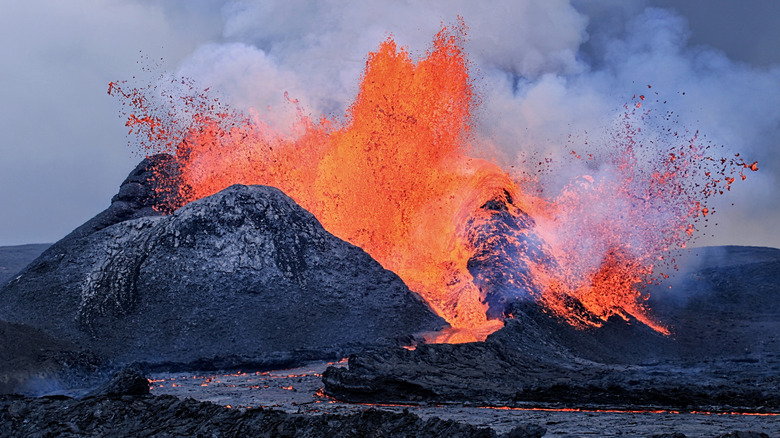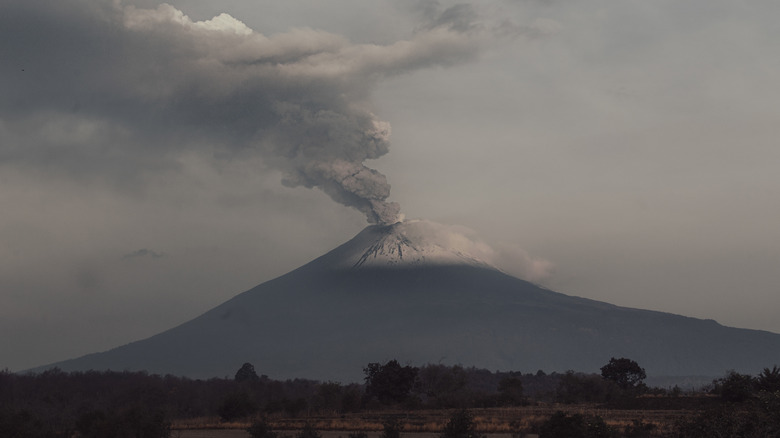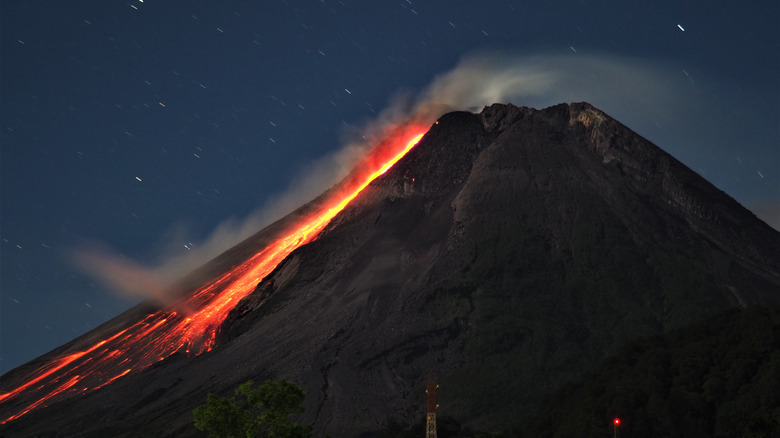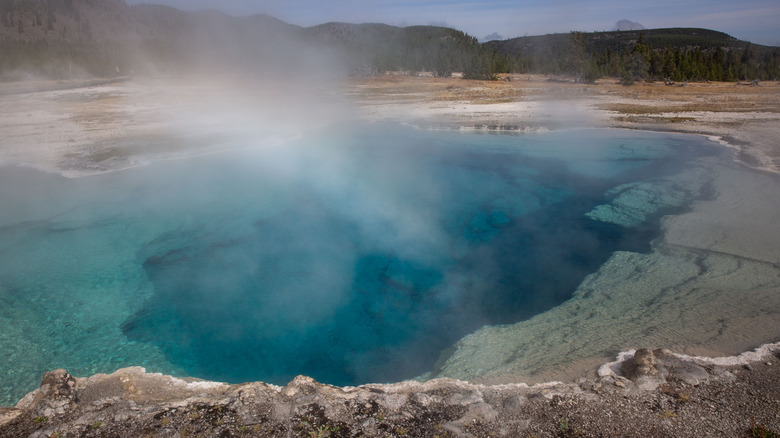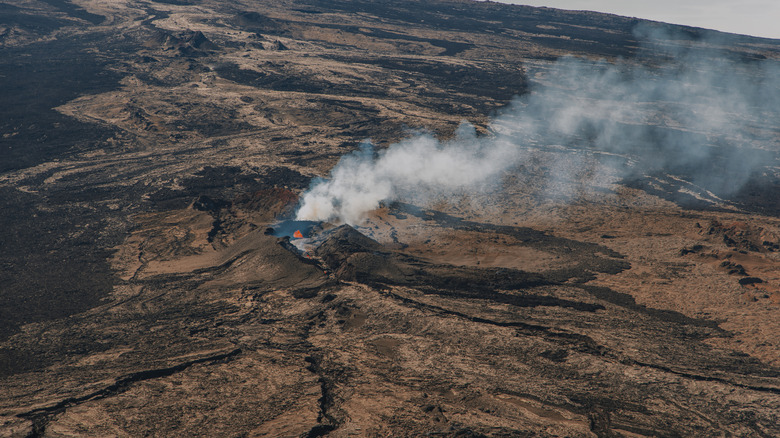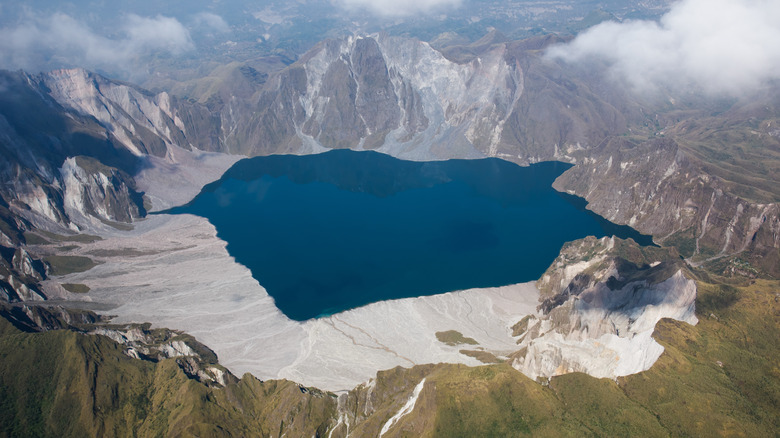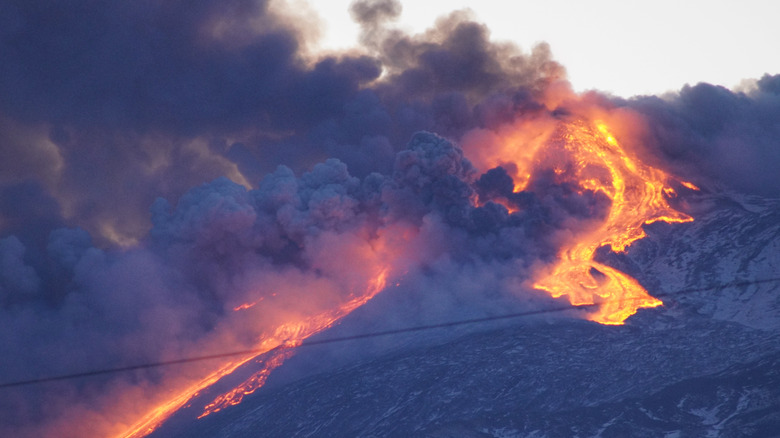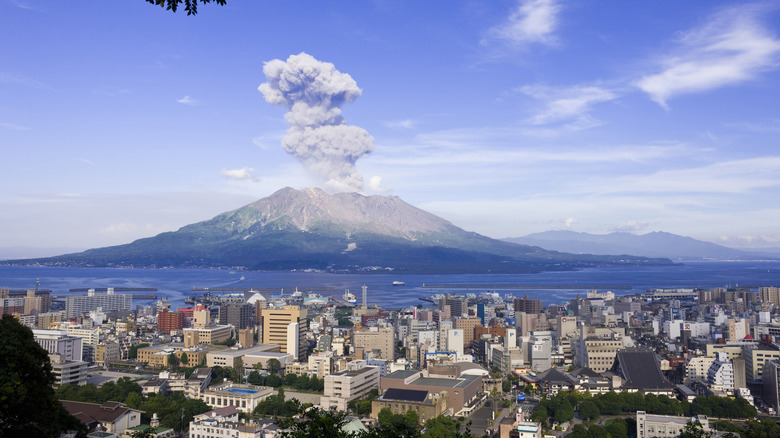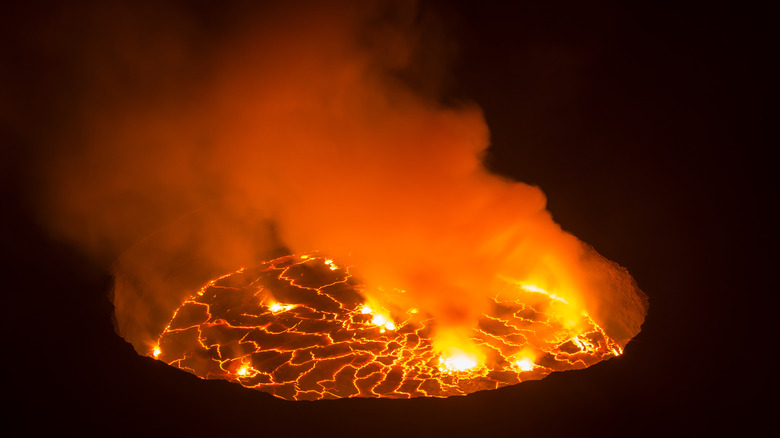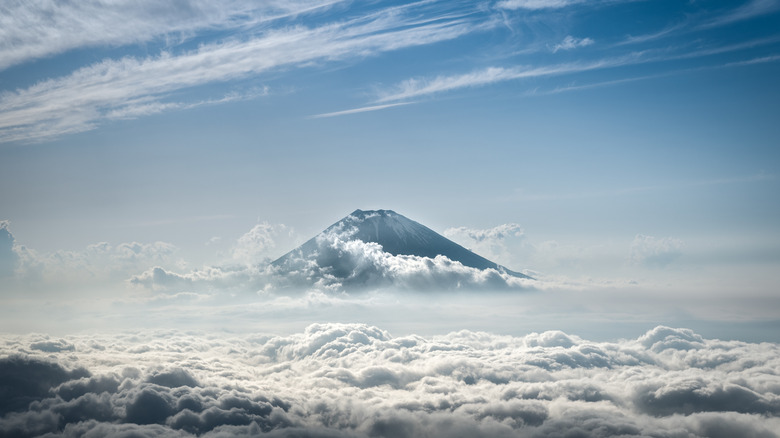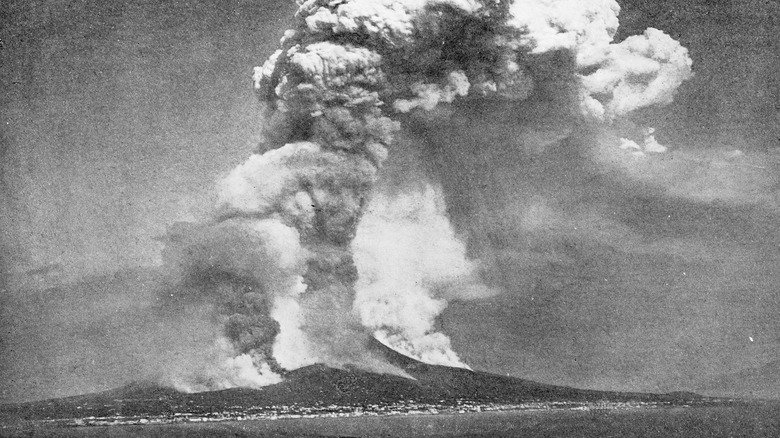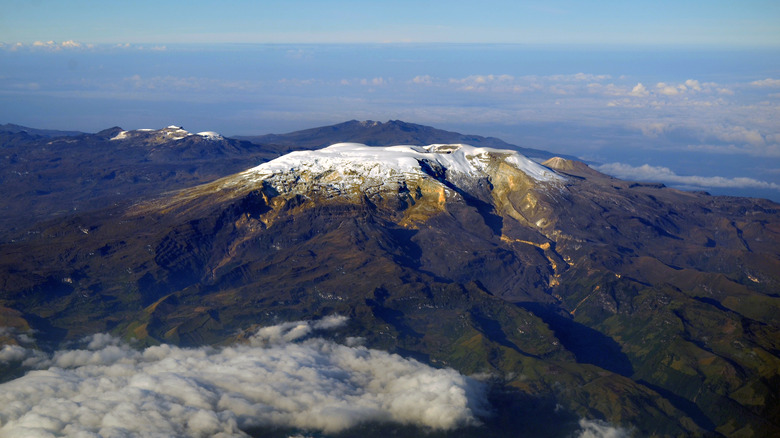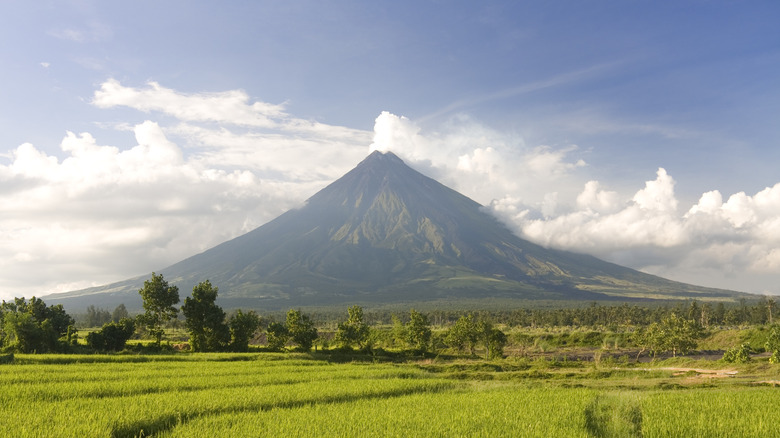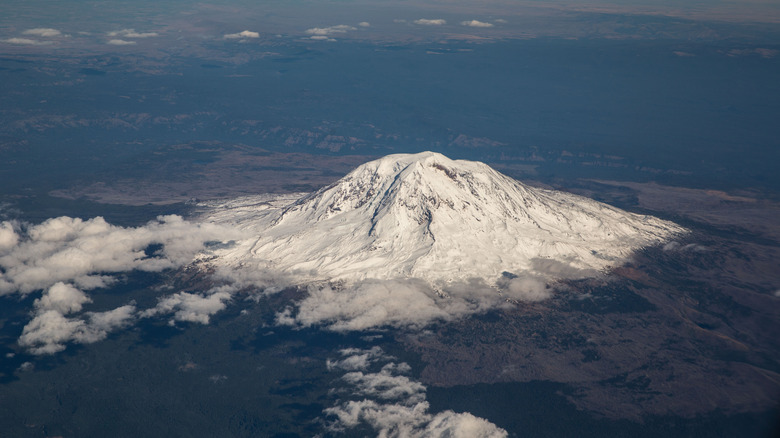Dangerous Volcanoes That Could Erupt At Any Time
Although volcano eruptions are sensationalized by the media, they're actually more common than you might think. Across the globe, there are between 1,300 and 1,500 active volcanoes, with almost 200 of them in the United States alone. And every continent in the world hosts an active volcano except for Australia. Dozens of volcanoes erupt every year, but using seismographs to predict eruptions has helped decrease the loss of human life associated with volcanic eruptions.
But despite the widespread nature of volcanoes and all of our prediction technology, volcanic eruptions still pose a huge threat to human life. And because the land next to volcanoes is incredibly fertile, many people continue living next to these capricious giants because their livelihoods depend on it.
At the end of the day, it's hard to find a volcano that isn't dangerous, keeping in mind it could erupt at any time. And it's estimated that between 9% and 12% of the world's population lives next to a volcano, as per Environmental Hazards. Because of this, refining evacuation procedures and establishing warning systems will be the only way that people can continue to live side-by-side with these forces of nature.
Popocatépetl (Mexico)
Popocatépetl, considered to be the most dangerous volcano in Mexico, has erupted over 30 times since A.D. 1345. Located in central Mexico and measuring over 17,000 feet above sea level, the name of the volcano translates to "Smoking Hill" in Nahuatl.
Smithsonian Institute writes that Popocatépetl's current eruption period has been going on since January 2005, leading to ash clouds, broken houses, falling ash, and deaths in and around Mexico City. The ash gets so bad that the airport in Mexico City has had to close as a result. But although these eruptions are dangerous and disruptive, they're comparatively small. According to the United States Geological Survey, Popocatépetl is believed to have its worst eruptions once every 1,000-2,000 years. The last massive eruption of Popocatépetl was around A.D. 800, so it's hopefully not due for another one for a while.
As of May 25, 2023, Popocatépetl has been erupting for a week, and the Mexican government has sent in up to 7,000 troops to help clean the ash and to assist in the event of an evacuation. Some 40 towns are considered to be in a state of emergency, and over 100,000 students have had their classes canceled as a result.
Mount Merapi (Indonesia)
With a name that translates to Fire Mountain in Indonesian and Javanese, it's no wonder that Mount Merapi is considered to be the most dangerous volcano in Indonesia out of over 120 other volcanoes. A highly active volcano, its most recent eruption was earlier in the year in March as of May 2023.
Mount Merapi is one of 16 volcanoes known as a Decade Volcano, which is a volcano that is studied by the International Association of Volcanology and Chemistry of the Earth's Interior (IAVCEI) due to its destructive nature and proximity to populated human settlements.
In 2010, numerous eruptions from Mount Merapi led to the deaths of nearly 400 people. Although the 250,000 people that live by Mount Merapi are typically evacuated during major eruptions, everyone isn't always able to evacuate and some people end up in the path of the hot gas and lava. And after the 2010 eruption, over 11,000 people remained displaced. But despite the dangers of Mount Merapi, hundreds of people continue to work as farmers next to the volcano due to the incredibly fertile land around the volcano.
Yellowstone Caldera (Wyoming)
Known for its natural marvels, there's actually something dangerous lurking underneath Yellowstone National Park in the United States. The Yellowstone Caldera is a volcanic crater left over after two super volcanoes erupted roughly 630,000 years ago. But beneath the benign-looking crater is another supervolcano that would have a devastating effect if it were to erupt, which it has been known to do numerous times.
The Yellowstone Caldera was originally created 2.1 million years ago out of what is believed to be one of the largest volcanic eruptions to have ever occurred. But luckily, scientists believe that the Yellowstone supervolcano isn't due to erupt for another 90,000 years. But in the event of an eruption, the Yellowstone supervolcano would release up to 240,000 cubic miles of rock and ash.
Because of the risk of eruption, scientists have been monitoring the Yellowstone supervolcano for over 30 years with 26 seismic stations. In addition, scientists monitor the volcano using 11 stream gauging stations because if the Yellowstone supervolcano does erupt, it's believed that the eruption could be hydrothermal rather than volcanic. These kinds of eruptions occur from steam that comes from geysers and hot springs.
Mauna Loa (Hawai'i)
Described by Reuters as "the world's largest active volcano," Mauna Loa erupted for the first time in almost 40 years in November 2022. Although the lava flows from the volcano can devastate homes and farmland on the island of Hawai'i, evacuations are possible because the lava usually takes about a week to travel down the volcano into the residential areas.
Comparatively, the volcanic gasses released by Mauna Loa, which contain a mixture of carbon dioxide and sulfur dioxide, pose much more of an immediate threat. During eruptions, Mauna Loa releases a mixture of gasses known as vog, or volcanic smog, that can cause headaches, burning eyes, and sore throats.
Mauna Loa also releases glass particles known as Pele's hair or Pele's tears. Named after the Hawaiian volcano deity Pele, the glass particles aren't too dangerous for people on the ground. However, the glass particles can be dangerous for overhead airplanes. And considering how the Hawai'i island chain is made up of 15 volcanos, there's always going to be a threat of eruption, even if it's not from Mauna Loa. The volcano Kīlauea, also on the island of Hawai'i, was continuously erupting from September 2021 to December 2022.
Mount Pinatubo (Philippines)
Some of the most dangerous volcanoes aren't dangerous because of their proximity to people. Instead, their danger lies in the effects their eruptions have on the whole world. Mount Pinatubo, a volcano located on the island of Luzon in the Philippines, is an example of a volcano that is doubly dangerous.
When Mount Pinatubo erupted on June 15, 1991, it became responsible for the second-largest volcanic eruption the 20th century has ever experienced. Up to 100,000 people lost their homes as a result, and almost 1,000 people were killed during the eruption and its aftermath. The eruption was so intense that the ash particles released affected weather across the globe. According to the National Oceanic and Atmospheric Administration, even the average global temperature dropped by 2.7°F, which lasted years. And just one year later, Mount Pinatubo had another eruption that was comparatively much less destructive, but it still claimed the lives of 72 people.
Despite wreaking havoc on crops and homes, the 1991 eruption of Mount Pinatubo wasn't as bad as it could've been because the Philippine Institute of Volcanology and Seismology and the U.S. Geological Survey issued a warning that led to evacuations before the volcano erupted.
Mount Etna (Italy)
Mount Etna may not be as dangerous as it used to be, but the largest volcano in Europe has a reputation for damage and devastation. Its volcanic activity has been recorded for over 2,500 years, with Mount Etna's largest eruption in March 1669 that had the longest lava flow ever created in the last 15,000 years, according to The Weather Network. The lava flow was so intense that it accumulated by the wall of Catania until it was pouring over the top of the 60-foot wall, George Poulett Scrope writes in "Volcanoes."
Located on the Italian island of Sicily near the city of Catania, Mount Etna erupts every few years. However, lava flows aren't as much of a threat as they used to be. The last time a town was destroyed by a lava flow was in 1928. However, the volcanic ash clouds still pose a serious threat. During an eruption in March 2017, clouds of hot gas and raining rocks led to numerous injuries among a group of tourists and a news crew. Planes also have trouble flying through volcanic ash clouds, as the clouds obscure the pilot's ability to see and can clog up the engines.
But despite Mount Etna's active nature, over 500,000 people live alongside its rumblings. In 2023, Mount Etna started erupting at the end of May, causing airport shutdowns due to the immense smoke clouds.
Sakurajima (Japan)
Located in Kyushu, Japan, Sakurajima has been erupting continuously for over 65 years. And although most of the eruptions aren't cause for concern, sometimes the intensity of the eruptions leads to evacuation warnings. ABC News reports that sometimes the vibrations from the erupting volcano are so intense that it causes windows in nearby Kagoshima to break. And during its 2022 eruption, volcanic rocks from Sakurajima were recorded falling over 1.5 miles away.
Sakurajima was originally an island, but after its 1914 eruption, which was the most powerful eruption in 20th-century Japan, it became a peninsula of Japan. And according to Science Alert, scientists think that Sakurajima is due for another similar eruption, due to estimates of how much magma is flowing into the volcano's reservoir.
People that live by Sakurajima are used to volcano evacuation drills, and Live Science writes that children even walk to school wearing hard hats to avoid potential rocks raining down on them. Although the high-level alerts can be worrisome because Sakurajima is heavily monitored, people usually have some kind of warning before an eruption. As a result, no one has died from Sakurajima's eruptions in over 10 years.
Mount Nyiragongo (Democratic Republic of the Congo)
When Mount Nyiragongo erupted in 2021, seismologists were caught completely unawares. Located in the Democratic Republic of the Congo near the town of Goma, Mount Nyiragongo erupted without any prior indications on the seismographs near the volcano. And because over 1 million people live around Mount Nyiragongo, the fact that it can suddenly erupt without warning is a cause of great concern. Due to the 2021 eruption, over 360,000 people were displaced, and many were unable to return to their land over a year after the eruption.
The lava flows of Mount Nyiragongo are especially dangerous due to the fact that its lava doesn't contain much silica. As a result, the lava is less viscous and moves quickly. Mount Nyiragongo also releases a great deal of sulfur dioxide. Relief Web writes that during the 2002 eruption, a lava lake was created that has been releasing gasses of sulfur dioxide ever since. The lava lake also means that the magma isn't pressurized out of the volcano, and it's usually the rumblings of pressure that indicate an eruption.
Mount Nyiragongo's deadliest eruption was in 1977, in which over 600 people died. And during the 2002 eruption, over 120,000 people lost their homes.
Mount Fuji (Japan)
Although Mount Fuji is famous for its aesthetic nature, lurking under its serene surface is still an active volcano. The last time Mount Fuji erupted was in 1707, and during this eruption volcanic ash reached as far as Tokyo. But although Mount Fuji hasn't erupted in over 300 years, scientists still monitor the volcano for any activity because if an eruption did occur, its effects could be devastating. So far occasional tremors have been recorded, but as of May 2023 Mount Fuji seems to be biding its time.
Reuters reports that in the event of an eruption, the volcanic ash would cause the Tokyo transport system to break down and clog up power plants. And considering that Mount Fuji's last eruption lasted around two weeks, this sort of standstill could have devastating effects. There's also the fear that a volcanic eruption could trigger an earthquake.
Located in central Honshu, Japan, Mount Fuji is only about 60 miles away from the city of Tokyo. This is why many real estate companies have invested in extra air conditioner filters, covers over rooftop drains, masks, goggles, and other protective gear for the residents of their buildings in Tokyo, reports NikkeiAsia.
Mount Vesuvius (Italy)
Roughly 365 miles north of Mount Etna is another Italian volcano that looms over its nearby residents. Mount Vesuvius, located in Naples, Italy, is the only active volcano on the European mainland and is considered to be the most dangerous volcano in all of Europe. Although its most famous eruption was almost 2,000 years ago, Mount Vesuvius has been known to wake from its slumbers to deliver devastation.
The eruption of Mount Vesuvius in A.D. 79 is considered to be its deadliest eruption, during which the cities of Pompeii and Herculaneum in Ancient Rome were completely destroyed. The eruption was so intense that the cities were blanketed by ash, pumice, and mud, freezing the city and its residents in their apocalyptic end. The eruption of Vesuvius is especially well-known because of the account of Pliny the Younger, who witnessed the eruption. Additionally, after the discovery of Pompeii and Herculaneum in 1784, many artists and writers who were inspired by the ruins started incorporating the eruption into numerous artistic works.
As of May 2023, the most recent eruption of Mount Vesuvius was in 1944, which claimed the lives of 26 people as hot ash and volcanic rocks rained from the sky. And although Mount Vesuvius has been quiet for almost 80 years, the devastation on the nearby population from an eruption could be catastrophic, which is why Mount Vesuvius is one of the most watched volcanoes in the world.
Nevado del Ruiz (Colombia)
In April 2023, Nevado del Ruiz, located near Bogotá in Colombia, started releasing clouds of smoke, signaling that an eruption might be imminent. And considering the devastation of its last eruption in 1985, many local residents are rightly worried.
Also known as the Armero tragedy, the 1985 eruption of Nevado del Ruiz is considered to be the second-deadliest volcanic eruption in the 20th century. Over 23,000 people died due to the mudflows caused by the eruption and in the town of Armero, 70% of people lost their lives. The only other eruption in the 20th century that was deadliest was the 1902 Mount Pelée eruption in Martinique.
Because of all the seismographs and warning systems currently in place, it's believed that an eruption today wouldn't result in such a mass loss of life. However, just because there's an impending eruption doesn't mean it's the lesser of two evils. CNN reports that many local residents have refused calls for evacuation because of what happened during previous evacuations. "In previous occasions they evacuated, floods [caused by the volcano] didn't affect their farms and when they came back the farmers found that most of their goods and cattle had been stolen," said local government official Omar Valdes.
Mayon Volcano (Philippines)
Mount Mayon is considered to be the most active volcano in the Philippines and because of its location on the constantly shifting Ring of Fire in the Pacific, it makes it relatively difficult to predict eruptions, making it especially dangerous. National Geographic writes that Mount Mayon has erupted around 60 times in the last 400 years, but the eruptions seem to be getting more frequent, as four eruptions have happened in the 21st century alone.
Up to 250,000 people live by Mount Mayon, and during eruptions there are evacuations of tens of thousands of people. Mount Mayon's biggest and deadliest eruption was in 1814, during which over 1,000 people were killed due to volcanic ash and mudslides, and the town of Cagsawa was completely destroyed.
Despite the dangers of eruption, Mount Mayon continues to attract tourists and sometimes, they get too close to the danger zone. In 2013, five people died while climbing Mount Mayon when ash erupted from the volcano. And thousands of people continue to live by the volcano simply because they cannot afford to move anywhere else. One farmer, Quintin Velardo, told NBC News that "I tell my grandchildren to study hard so they can live elsewhere without a volcano to keep an eye on all your life."
Mount St. Helens (Washington)
Sometimes, it's not the volcano itself that's the most dangerous. Instead, its aftereffects can be even deadlier than the eruption. And that's exactly what happened when Mount St. Helens erupted in May 1980. The eruption was so intense that it caused the biggest landslide ever recorded.
The eruption itself was also tremendously devastating. Within 10 minutes, everything in almost 250 square miles was killed, including 7,000 large animals and 57 people, writes LiveScience. Even the surrounding forest couldn't withstand the explosion and lay flattened against the ground. The eruption also caused a series of earthquakes that led to the subsequent landslide. After its 1980 eruption, Mount St. Helens was quiet for almost 20 years. But then suddenly, between 2004 and 2008, it started rumbling once again, reawakening fears of an eruption. However, the rumblings in the early 2000s didn't come with any major eruptions and mostly consisted of small earthquakes and a few ash explosions.
The threat of another eruption still looms over Mount St. Helens. And Royal Society Open Science reports that as rainfall increases around Mount St. Helens, the danger of landslides after an eruption also increases. As a result, Mount St. Helens remains one of the most dangerous volcanoes in the United States.
